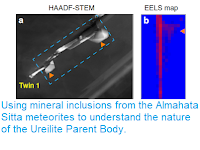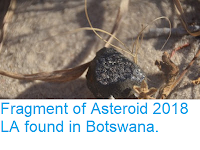A Michigan man has discovered he is in possession of a highly unusual meteorite after taking the object to a specialist to have it checked. David Mazurek from Edmore near Mount Pleasant obtained the rock with a farm he bought in 1988, and had been using it as a doorstop since, but contacted scientist Mona Sirbescu of the Department of Earth and Atmospheric Sciences at Central Michigan University, after seeing similar rocks being diagnosed as meteorites in news reports. The rock was in a barn on the property when he obtained it, with the previous owner claiming his father has seen it fall from the sky in the 1930s, and that it was still hot to the touch when found in a crater.
The Edmore Meteorite. Central Michigan University.
The part of the story about the discovery of the rock is probably apocryphal; meteorites are not usually hot to the touch when found, as the fragments that fall to Earth are typically from the inside of larger bodies that have exploded higher in the atmosphere. The friction between an object falling through the atmosphere and the molecules that make up the atmosphere is not enough to cause significant heating, but an object that enters the Earth’s atmosphere from space will generally be travelling at a far higher speed, due to the momentum from its own orbital path, which is enough to cause frictional heating. This friction will cause the outer layers of the object to become superheated, while the interior remains at the temperature that it was at in space, typically a few degrees above absolute zero. This temperature difference typically causes the object to burn then explode as a bright meteor, with left over pieces of the object’s interior falling to the ground as meteorites (bright lights in the sky are meteors, lumps of rock of extra-terrestrial origin are meteorites), which start out very cold and are not warmed significantly by their decent.
Sirbescu quickly concluded that the object was an nickel-iron meteorite (the first actual meteorite brought to her by a member of the public in 18 years), weighing about 10 kg, making it the sixth largest meteorite ever discovered in Michigan. Interestingly the meteorite appears to be about 88% iron and about 12% nickel, a higher proportion of nickel than most such objects (which are typically 90-95% iron and 5-10% nickel), which has aroused interest among meteorite collectors, with both the Smithsonian Institution and an independent mineral museum in Maine reportedly interested in obtaining the object (though the figure of US$100 000 widely quoted in the media is probably a little higher than the true value of the object).
Sirbescu quickly concluded that the object was an nickel-iron meteorite (the first actual meteorite brought to her by a member of the public in 18 years), weighing about 10 kg, making it the sixth largest meteorite ever discovered in Michigan. Interestingly the meteorite appears to be about 88% iron and about 12% nickel, a higher proportion of nickel than most such objects (which are typically 90-95% iron and 5-10% nickel), which has aroused interest among meteorite collectors, with both the Smithsonian Institution and an independent mineral museum in Maine reportedly interested in obtaining the object (though the figure of US$100 000 widely quoted in the media is probably a little higher than the true value of the object).
Nickel-iron meteorites, or octahedrites, are the most common class of meteorite, being comprised largely of iron with a substantial amount of nickel, leading to the formation of the mineral kamacite, which has an octahedral form, giving these meteorites their name. Strictly speaking iron meteorites are less common than stony meteorites, but they are much more commonly found as they are resilient both to atmospheric entry and terrestrial weathering, and relatively easy to recognise. Only about 5.7% of objects entering the atmosphere are thought to be iron meteorites, but they comprise about 90% of objects in collections. Nickel-iron meteorites are the most common form of iron meteorite, though low-nickel meteorites hexahedrites, are also found. Both are thought to have formed within the interior of large planetesimals in the early Solar System. These bodies were large enough to develop differentiated iron cores (as is seen in the Earth today), but which were subsequently torn apart by tidal forces generated by the larger planets.
See also...
Follow Sciency Thoughts on Facebook.







